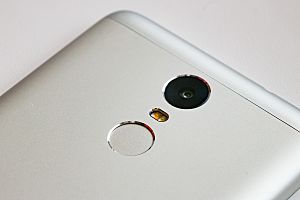Fingerprint scanner facts for kids
Fingerprint scanners are cool gadgets that help keep things safe. They use your unique fingerprints to know who you are. You can find them in many places, like on your smartphone, at a police station, or even to get into a secure building. They are a type of biometrics technology, which means they use your body's unique features for identification.
Contents
What Are Fingerprints?
Your fingers have special patterns of tiny lines and ridges. These patterns are called fingerprints. Everyone has different fingerprints, even identical twins! These patterns stay the same your whole life and are very hard to change. Because each person's fingerprints are so unique, they are perfect for telling people apart.
How Do Fingerprint Scanners Work?
There are four main types of fingerprint scanners: optical scanners, capacitance scanners, ultrasonic scanners, and thermal scanners. No matter the type, every scanner's main job is to take a picture of your fingerprint. Then, it tries to find a match for it in its database. The quality of the fingerprint picture is measured in dots per inch (DPI).
- Optical scanners take a visual picture of your fingerprint. They use a digital camera, much like the one in your phone.
- Capacitive or CMOS scanners use capacitors and tiny electric currents. They create an image of your fingerprint based on how your finger touches the surface. These scanners are often very accurate.
- Ultrasonic fingerprint scanners use high frequency sound waves. These sound waves go through the outer layer of your skin. This helps them get a very detailed image of your fingerprint.
- Thermal scanners sense tiny temperature differences on the surface. They can tell the difference between the ridges (raised parts) and valleys (lower parts) of your fingerprint.
Sometimes, fingerprint scanners can be tricked. People have found ways to create fake fingerprints to try and fool the scanner.
Different Types of Scanners You Might See
Fingerprint scanners come in two main designs: stagnant and moving.
- Stagnant scanners: With these, you have to drag your finger across a small scanning area. They are usually cheaper. However, the image might not be perfect if you don't move your finger at a steady speed.
- Moving scanners: For these, your finger stays still on the scanning area. The scanner itself moves underneath your finger. Because the scanner moves at a constant speed, it usually gets a much better image of your fingerprint.
Where Are Fingerprint Scanners Used?
Fingerprint scanners are used in many different places and industries.
Stand-Alone Readers
Some fingerprint readers are separate devices. For example, Microsoft released a fingerprint reader way back in 2005. These can be plugged into computers.
Built-In Readers
Many devices have fingerprint readers built right into them.
- Laptops: Since the early 2000s, some laptops have had fingerprint readers. For example, some Compaq laptops could have an external reader added. IBM started putting readers directly into their laptops in 2004.
- Smartphones: Apple introduced its fingerprint recognition, called Touch ID, on smartphones in 2013. They added it to laptops in 2016. On laptops and smartphones, the fingerprint sensor usually connects using USB or I2C technology.
See also
 In Spanish: Sensor de huella digital para niños
In Spanish: Sensor de huella digital para niños



